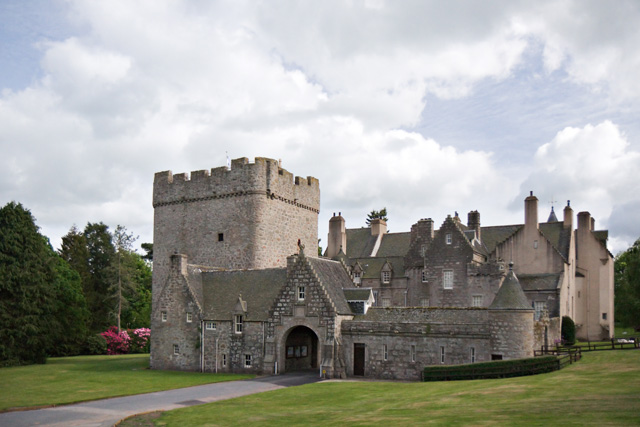Drum Castle

Drum Castle Photo - Ikiwaner -
Wikipedia - lic. under CC BY 3.0

Castle Facts:
Location: Drumoak, Aberdeenshire, Scotland.
Built: 13th century-16th century.
Condition: Preserved.
Ownership / Access: National Trust for Scotland.
Opening Times: Open during the summer months. The chapel, dining hall and estate may be hired for weddings and corporate functions.
Price of Admission: Check their website for more info.
Notes: Drum Castle is a castle near Drumoak in Aberdeenshire, Scotland. For centuries it was the seat of the chief of Clan Irvine. The place name Drum is derived from Gaelic druim, 'ridge'.
The original 13th-century tower of Drum Castle has been suggested as the work of medieval architect Richard Cementarius, who built the Bridge of Don in Old Aberdeen. It is believed to be one of the three oldest tower houses in Scotland (and notably unaltered). A large wing was added in 1619 by the 9th laird, and further alterations were made during the Victorian era.
The castle and its grounds were granted to William de Irwyn in 1325 by Robert the Bruce, and remained in the possession of Clan Irvine until 1975. William de Irwyn (of the Irvings of Bonshaw clan) was armour bearer/secretary (and neighbor) to King Robert the Bruce. Drum played a role in the Covenanting Rebellion (as did nearby Muchalls Castle) leading to its being attacked and sacked three times. The castle is surrounded by late 18th-century gardens, including a rose garden and arboretum containing trees from all regions of the 18th century British Empire.
Today, the castle is owned by the National Trust for Scotland and is open during the summer months. The chapel, dining hall and estate may be hired for weddings and corporate functions. A variety of local events such as classic car rallies and musical fetes also occur here. There is also a small shop and tearoom within the castle.
How To Get To Drum Castle (Map):
Drum Castle Links:
Drum Castle On WikipediaVisit Banchory Website




